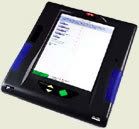Election integrity in peril, Part 1
 The Florida Fair Elections Center released a report last week into the cause of the uncounted votes in the 2006 Congressional District 13 race in Sarasota County, and its conclusions deserve the attention of everyone who cares about the integrity of the U.S. electoral system.
The Florida Fair Elections Center released a report last week into the cause of the uncounted votes in the 2006 Congressional District 13 race in Sarasota County, and its conclusions deserve the attention of everyone who cares about the integrity of the U.S. electoral system.
To refresh your memory, the contest pitted businessman Vern Buchanan, a Republican, against banker Christine Jennings, a Democrat. Buchanan won by 369 votes, but 14.9 percent of the ballots cast in Sarasota County -- a total of 17,846 ballots -- showed no vote for either candidate. By way of comparison, the undervote rate in neighboring counties was only about 2 percent. At the time of the 2006 election, Sarasota County employed iVotronic direct recording electronic (DRE) machines supplied by Nebraska-based Election Systems & Software Inc.
The uncounted votes led to two lawsuits challenging the election. While Jennings has dropped hers to try again for the same seat this year, a nonpartisan suit to overturn the race is still ongoing. The problems with the election also led to a joint investigation by a U.S. House committee and the Government Accountability Office, with an October 2007 GAO report [PDF] on its preliminary probe cautiously concluding that additional tests "would not provide absolute assurance that the iVotronic DREs did not cause the large undervote in Sarasota County."
The Florida Fair Elections Center conducted its own investigation, spending a year examining numerous records from Sarasota as well as other counties that used the same touch screen systems: ES&S Release 4.5, Version 2, with 12.1-inch screens and iVotronic firmware version 8.0.1.2 -- a type of firmware, by the way, that was never federally qualified and certified only in Florida. The Center draws a less tentative conclusion than the GAO about the ES&S equipment:
What we uncovered in our investigation is shocking: The iVotronic voting system failed to count over 100,000 votes in various races across the state of Florida in the November 2006 election. Furthermore, we have completely refuted the theories that substantial numbers of voters intentionally withheld their votes in the CD-13 race or that so-called "poor ballot design" was responsible for the uncounted votes. By process of elimination, the only remaining possible cause of the high undervotes is the catastrophic failure of the iVotronic voting system ... .
Most important, we found a badly designed, shoddily-built, poorly maintained, aging voting system in a state of critical breakdown.
Among the problems the Center found were large-scale and multiple machine malfunctions, evidence of unapproved and unauthorized firmware and software installation, and misconduct of elections officials that included nondisclosure of problems and access to voting equipment granted to unauthorized persons. The Center also found that Florida Department of State auditors ignored evidence of these problems and omitted essential areas of investigation that would have offered evidence of widespread machine failures.
Since the troubled election, Sarasota County has ditched the iVotronic system for optical scanned paper ballots, and Florida as a whole plans to switch to paper ballots after the upcoming election. But ES&S still provides almost half of all electronic voting machines used in the United States -- and Florida is not the only state that's experienced serious problems with the company's products:
* In August 2006, ES&S agreed to a $750,000 settlement in a lawsuit brought by the Indiana government after software problems resulted in delays for voters during the state's primary.
* Six counties in Illinois are currently experiencing problems with ES&S equipment that are forcing elections officials to work overtime to get ready for Election Day.
* Wharton County, Texas recently decided to do away with the ES&S iVotronic machines and turn to paper ballots after a voter in last November's election on state propositions complained -- and election officials confirmed -- that the equipment switched his choices from yes to no or no to yes.
* Last month, the Colorado Secretary of State decertified all of ES&S's current hardware and software -- as well as equipment from two other manufacturers -- after it failed state reliability tests.
* Just last week, ES&S and San Francisco announced a settlement in a lawsuit over the company's AutoMARK ballot machines after malfunctions necessitated a handcount that cost the city $400,000. In addition, California has filed a $15 million lawsuit against the company for illegally supplying 972 non-certified machines to five counties.
* A recent report by the Ohio Secretary of State on three electronic voting systems used in that state found serious problems with all of them -- including one system manufactured by ES&S.
* And during the Jan. 19 Republican presidential primary in Horry County, S.C., ES&S iVotronic equipment malfunctioned in some 80 percent of precincts due to programming problems -- and officials then ran out of paper ballots, leading some citizens to cast their votes on scraps of paper. Fortunately, there were no widespread problems during the state's Democratic primary on Saturday.
ES&S has rejected criticism of its equipment, dismissing the report by the Florida Fair Elections Center as biased and insisting that its systems are reliable, accurate and secure. One wishes the company were right, since -- as the Center warns -- nearly one-third of Florida's voters will cast their ballots on ES&S equipment in the Jan. 29 presidential primary.
(Image of iVotronic unit from the ES&S Web site.)
Tags
Sue Sturgis
Sue is the former editorial director of Facing South and the Institute for Southern Studies.
